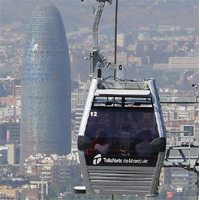The City from the Wire: the Aerial Cable Transport for the Urban Mobility
Abstract
The urban transfer oriented climbing slopes, jumps and singularities of altitude topography found within cities, particularly those hills, is of considerable interest in the analysis of the relationship between mobility and urban land management in covering a considerable range of physical/functional factors can produce impacts and externalities which, if well-managed, can trigger processes reliever, sustainable development and promoting tourism inside the city. The article starts from the consideration of urban transport by ropeways as a viable, effective alternative to the collective transfer among different areas of the city, particularly in those cities which are characterized by unique morphological or hydrographic territory of which lend themselves to be ‘dated’ by mobility systems at high altitude. These features, in many international urban context, also contribute to enhance the amenity and the urban appeal. The paper seeks to emphasize how the ropeways can becomes efficient urban transport system between locations in the city, often placed at different heights and for which there is a less accessibility by ground, and at the same time, a fascinating way of tourist mobility that allow people to observe the city from above (moving on it), in a sort of dynamic view. This interesting functional convergence has been often highlighted in the studies conducted on this mode of transportation which in the past was considered one of the real possibilities for urban moving. Many cities are characterized by this type of mobility and within which existing systems of lifts, oblique connection between parts of the city secured by urban systems, lifts, cable cars, escalators, moving walkways, etc. . A focus it is also provided in relation to the ropeways, currently operating in many cities around the world, highlighting the effectiveness of mobility solutions at high altitude, although not necessarily intended for the slope, taken in metropolitan contexts outside of Europe since the ‘ 70 year. Furthermore a specific attention it is payed to the plants currently disused in Turin and in Naples with a special regard to the possible recovery prospects in a new urban mobility system. For the city of Naples it is presented also a new project for a rope way between the two famous museums: the Archeological, which is located inside the inner city, and the Capodimonte one which is at top if the hill of Capodimonte inside the well known area of the royal palace. Finally some new projects are presented regarding the cities of Rome and Milan. For the two biggest Italian cities, there are two ropeways designed that will, in the case of Milan, to link urban areas along a path that includes interchanges and stations in major urban hubs, starting from the airport; in the case of Rome the “link” will cross the river Tevere in order to connect two large districts of the city: the EUR and Magliana, historically splitted by the barrier river.Downloads
References
Verne, J. (1995), Parigi nel XX secolo, Tascabili Economici Newton, Roma.
Alexander James Wallis-Tayler, (1920), Aerial or wire ropeways: their construction and management, C. Lockwood and son, London.
Capasso, A. (a cura di) (2001), Trasporto verticale e città. Gli impianti di risalita nella mobilità urbana. Dagli ascensori alle funivie, CLEAN, Napoli.

Copyright (c) 2014 Tema. Journal of Land Use, Mobility and Environment

This work is licensed under a Creative Commons Attribution 4.0 International License.
Authors who publish in this journal agree to the following:
1. Authors retain the rights to their work and give in to the journal the right of first publication of the work simultaneously licensed under a Creative Commons License - Attribution that allows others to share the work indicating the authorship and the initial publication in this journal.
2. Authors can adhere to other agreements of non-exclusive license for the distribution of the published version of the work (ex. To deposit it in an institutional repository or to publish it in a monography), provided to indicate that the document was first published in this journal.
3. Authors can distribute their work online (ex. In institutional repositories or in their website) prior to and during the submission process, as it can lead to productive exchanges and it can increase the quotations of the published work (See The Effect of Open Access)
